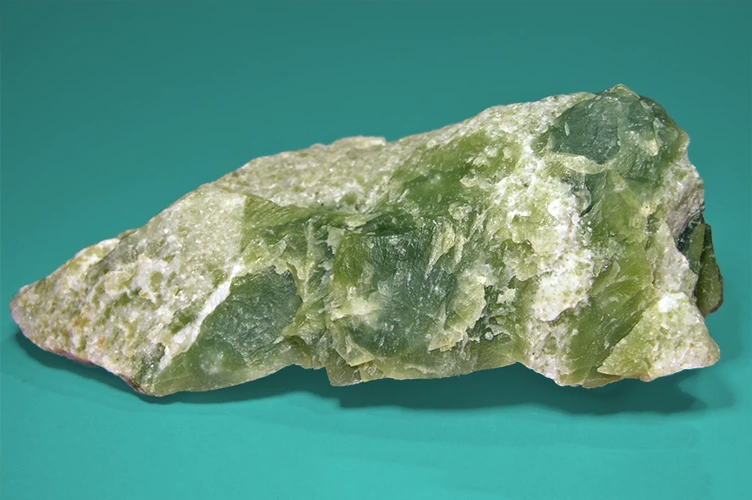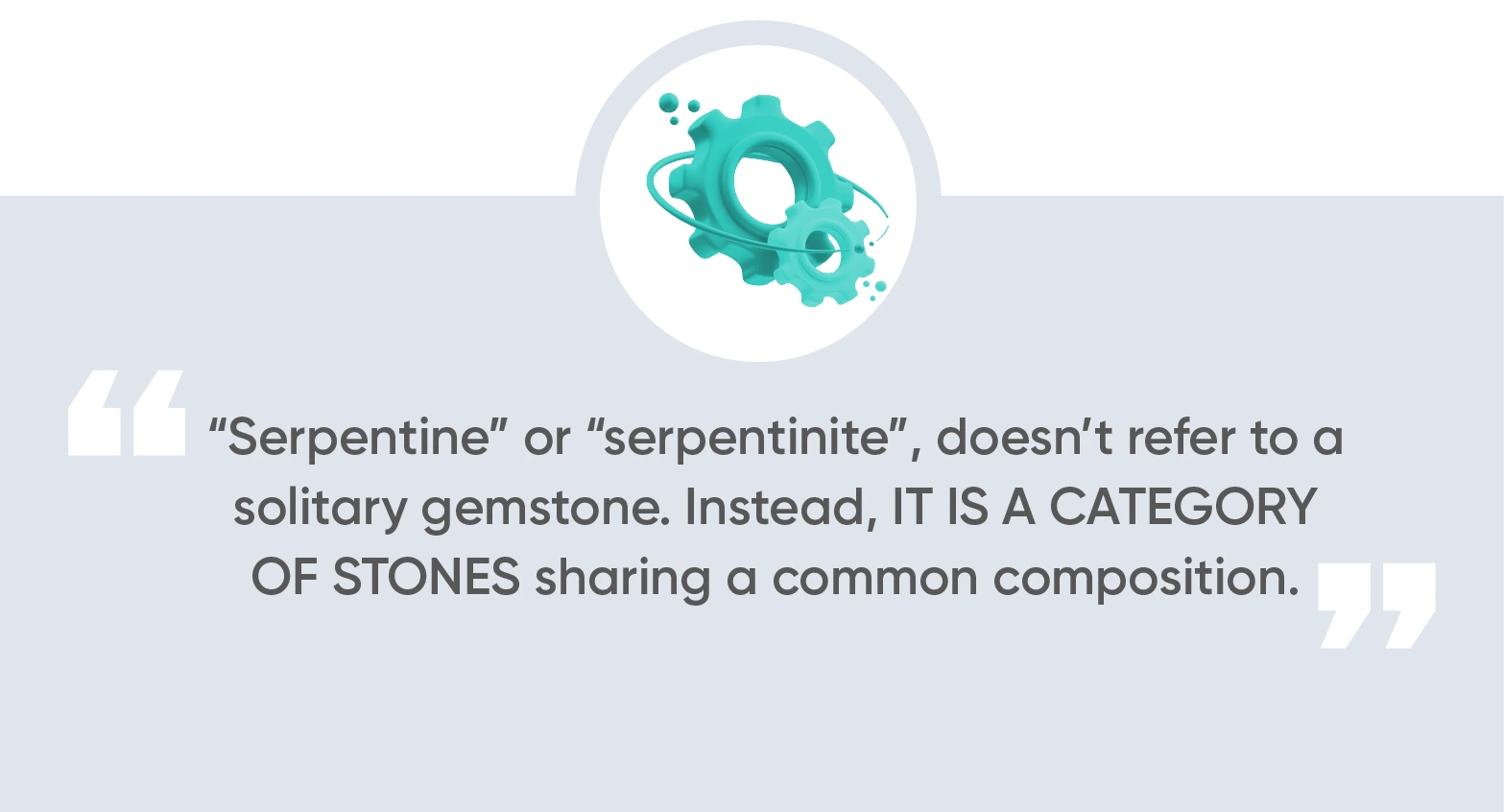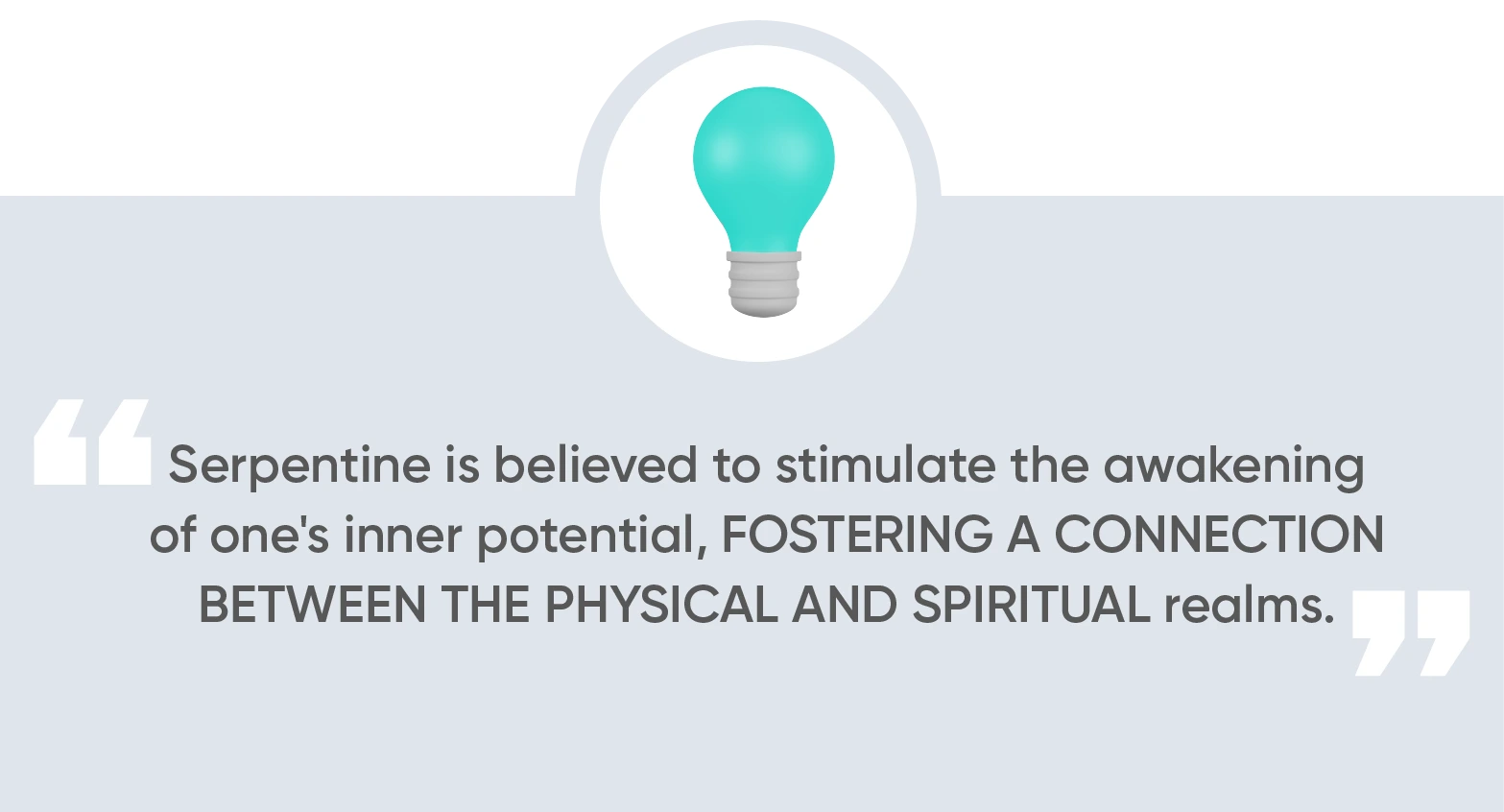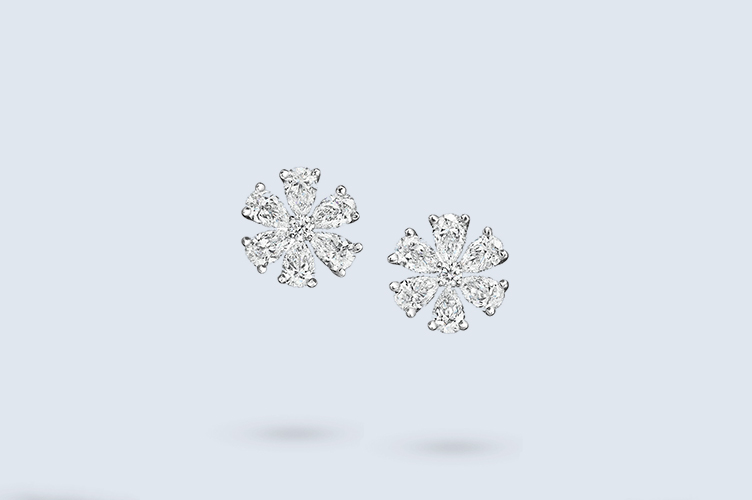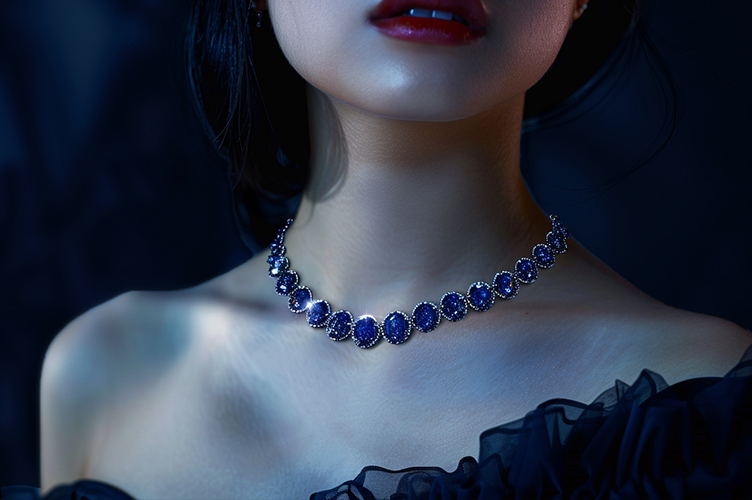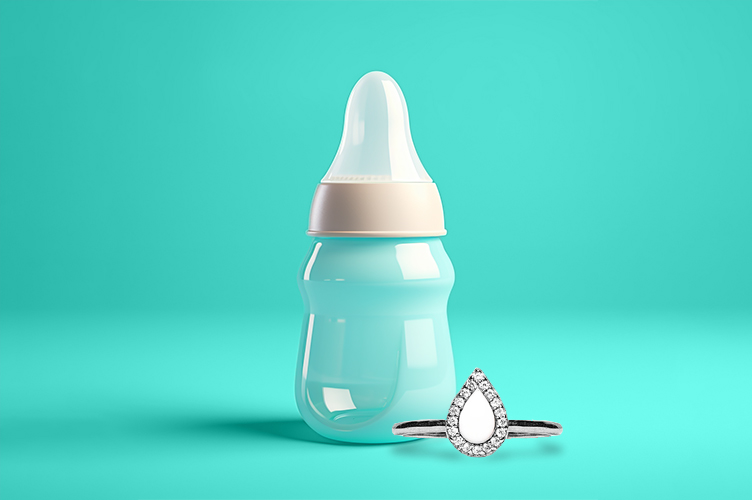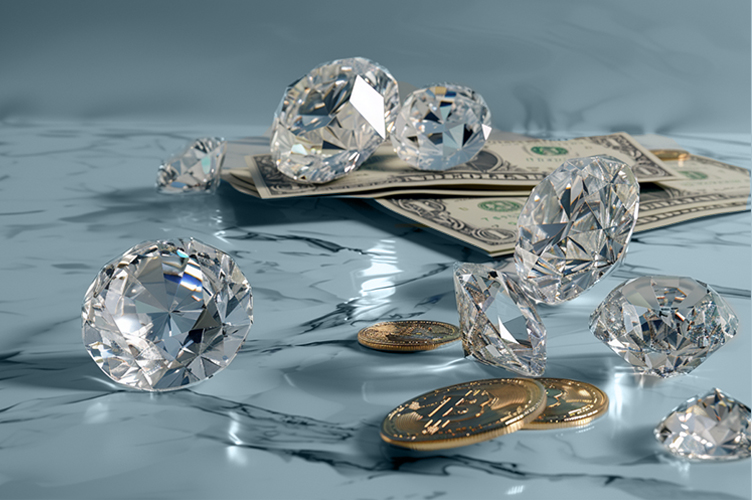With its vibrant hue and distinctive patterns, serpentine jewelry offers a breathtaking appearance and unique qualities that set it apart from other widely recognized gems such as diamonds, rubies, sapphires, and emeralds.
Intrigued? Keep reading for a comprehensive guide to everything related to the serpentine stone.
What You Will Learn
- What is Serpentine and How is it Formed?
- Where is Serpentine Found? Origins of Serpentine Rock
- The History of Serpentine Jewelry and Serpentine Gems
- Serpentine Meaning and Symbolism
- Serpentine Variations: Which Serpentine Subgroup is Your Favorite?
- Serpentine Patterns
- Serpentine Jewelry Today
- Caring for Serpentine Jewelry
- Protect Your Investment
What is Serpentine and How is it Formed?
What is serpentine stone? At its simplest, serpentine stone is a mineral that exhibits a diverse range of colors and patterns, is known for its unique aesthetic appeal, and is often used in jewelry and decorative objects.
“Serpentine” doesn’t refer to a solitary gemstone, though. Instead, serpentine, or serpentinite, is a category of stones sharing a common composition. It’s an umbrella term for a set of ultramafic rocks within the broader serpentine group minerals. Predominantly composed of magnesium, serpentine minerals often originate from the alteration of minerals such as olivine or pyroxenes in the earth’s crust, occurring under specific temperature and pressure conditions.
The serpentine group encompasses not only serpentine but also antigorite, lizardite, and chrysotile, each a green stone with a scaly appearance and sharing a fundamental chemical structure.
- Antigorite: This serpentine mineral presents a fibrous or scaly appearance and is commonly found in metamorphic rocks.
- Lizardite: This serpentine mineral develops under reduced heat conditions and features a platy or scaly structure and distinctive yellow green coloration with lizard scale-like patterns.
- Chrysotile: Recognized for its fibrous appearance, chrysotile is commonly known as asbestos and is widely used in industrial applications.
Displaying an array of colors and textures, serpentine minerals are often transformed into gemstones and decorative objects. Their distinct properties and cultural, metaphysical, and holistic associations contribute to their diverse applications.
Where is Serpentine Found? Origins of Serpentine Rock
The United States boasts serpentine deposits in California, Arizona, and Pennsylvania.
Beyond the United States, serpentine is found in Afghanistan, where the country’s rugged mountains are home to deposits of high-quality serpentine. In New Zealand, the South Island boasts notable deposits, particularly in districts like Westland and Otago. The gemstone has also been identified in the United Kingdom, with occurrences in Cornwall and the Lizard Peninsula.
In South Africa, serpentine deposits contribute to the country’s rich mineral diversity. The varying geological serpentine formations in these regions play a crucial role in the development and unique characteristics of serpentine, giving rise to its distinct colors and patterns.
Other significant sources include Italy, where serpentine is found in Tuscany, and China, where deposits are scattered across various provinces.
The History of Serpentine Jewelry and Serpentine Gems
The name “serpentine,” derived from the Latin “serpens” meaning “snake,” encapsulates this gemstone’s historical significance. Renowned for its resemblance to the intricate patterns found on serpent skins, serpentine has been an object of fascination since ancient times.
As far back as the Greeks and Romans, serpentine was used to craft intricate vessels, amulets, and jewelry, a testament to its early recognition as a valuable ornamental material. Ancient cultures also attributed mystical properties to serpentine, considering it a protective gemstone to be used against venomous bites and malevolent forces.
During the Renaissance, serpentine experienced a resurgence in popularity, particularly in Europe, where it adorned royal palaces and ecclesiastical structures. The gemstone’s unique mottled appearance and diverse color spectrum, ranging from dark greens to soothing blues, captivated the imaginations of artists and lapidaries, leading to its incorporation into decorative objects and architectural embellishments.
In the 19th century, serpentine’s association with architectural elements expanded, as it became a popular choice for decorative stone elements and inlay work. The gemstone’s application in pillars, flooring, and intricate designs showcased its versatility beyond jewelry, solidifying its status as a cherished ornamental material.
Today, serpentine gemstones continue to charm contemporary artisans and gem enthusiasts.
Serpentine Meaning and Symbolism
Beyond its physical beauty, serpentine crystal is renowned for its intriguing metaphysical properties, captivating spiritual seekers and healers for centuries.
Embraced as a stone of transformation, serpentine is believed to stimulate the awakening of one’s inner potential, fostering a connection between the physical and spiritual realms. With its earthy energies and spirit serpentine grounds, and is believed to help balance the chakras, particularly the heart and crown chakras, promoting a harmonious flow of energy.
Additionally, this gemstone is often considered a guardian of well-being, with its reputed ability to alleviate mental and emotional imbalance and promote a sense of calmness.
Whether used for meditation, energy work, or as a wearable talisman, serpentine’s metaphysical properties continue to draw those seeking a deeper connection to the spiritual dimensions and a harmonious alignment with the energies of the universe.
Serpentine Variations: Which Serpentine Subgroup is Your Favorite?
Serpentine gemstones exhibit a remarkable range of colors and patterns for a diverse range of serpentine jewelry. While classic green tones are prevalent, serpentine can also showcase hues ranging from light yellow green to deep, earthy dark greens. Some serpentine gems even feature streaks or spots of contrasting colors, adding an extra layer of visual intrigue and making for a versatile decorative stone.
- Green Serpentine Stone
From vibrant lime to soothing mint and dark forest green, serpentine gemstones showcase the entire spectrum of green hues. Some take on an earthy tinge, leaning toward olive or moss, adding a touch of nature’s elegance to the ornamental material.
Mottling, banding, and striating are common features of green stone serpentine, with variations often manifesting in different shades. However, this versatile gemstone can also feature intriguing cream, brown, or white markings, creating a mottled appearance that enhances its visual complexity.
- Blue Serpentine
Blue green serpentine gemstones are a captivating alternative to the classic green. With shades resembling denim or navy, these gemstones exhibit striking patterns, with stripes or a mottled appearance.
- Red Serpentine
Deeper, earthier shades, such as brick, maroon, or mahogany, characterize red serpentine.
Serpentine Patterns
Serpentine patterns are as diverse as serpentine colors. Some stones boast a smooth, uniform texture, while others display intricate veins and inclusions that create a serpentine marble effect. These variations ensure each piece of serpentine jewelry is unique
Serpentine Jewelry Today
Serpentine jewelry touts a timeless appeal that’s hard to ignore. Its captivating colors and unique patterns make it a real showstopper, and how it complements various metals adds to its charm. However, you won’t stumble upon serpentine jewelry in your usual chain stores.
Serpentine, for all its beauty, is a bit of a rebel. Each stone has a personality, making every piece uniquely different. While fantastic for aesthetics, this individuality doesn’t always play well with mass production.
This is where boutique designers swoop in. Smaller artisans work with serpentine more often, as they work on jewelry in smaller batches and can dance around the peculiarities of each stone. When you shop small or local, you’ll find that artisans use serpentine for everything from delicate cabochons to more decorative objects. Some even go for the raw, organic vibe with tumbled green serpentine rocks, letting the stone maintain its natural shape and putting its color and pattern on full display.
Caring for Serpentine Jewelry
Serpentine is a soft and porous mineral. To maintain the stone’s luster and prevent damage, you must handle it carefully.
- Cleaning: Use a soft, dampened cloth with just water to gently wipe your serpentine jewelry’s surface. Avoid harsh chemicals or abrasive cleaners. For intricate jewelry designs, utilize a soft brush to reach into crevices.
- Storing: Keep serpentine jewelry in a soft pouch or lined jewelry box to protect it from scratches and dust. Store each piece separately to prevent potential scratching from contact with other jewelry. Avoid exposing serpentine jewelry to extreme temperatures or prolonged sunlight to maintain its vibrant colors.
- Handling: Remove serpentine jewelry before engaging in activities that may expose it to excessive pressure or impact. Apply cosmetics, perfumes, and hairsprays before putting on serpentine jewelry to prevent chemical interactions.
Protect Your Investment
Serpentine jewelry continues to make its mark today, just as it has for centuries. Ensure your serpentine jewelry is safeguarded for decades and generations to come with specialized jewelry insurance.
At BriteCo, we offer comprehensive and cost-effective jewelry insurance coverage. Our policies protect against loss, theft, and damage worldwide, ensuring your jewelry, including serpentine jewelry, is safeguarded with confidence.
To learn more, contact us directly or use our convenient online tool to obtain a personalized insurance quote.
Also Check:
What is Breast Milk Jewelry?
The Best Jewelry for High Neck Dress Outfits
What to Do with Old Jewelry: 4 Creative DIY Ideas
Who Invented Jewelry? | BriteCo Jewelry Insurance


